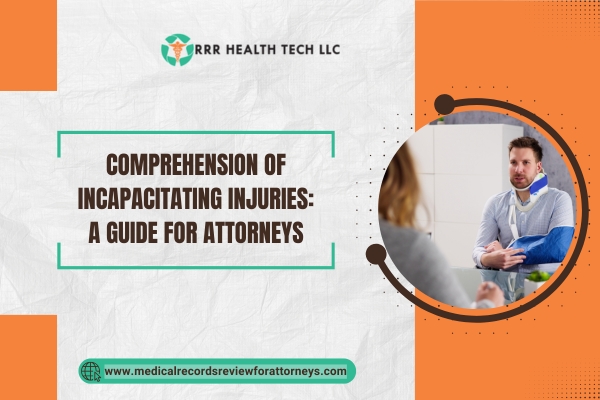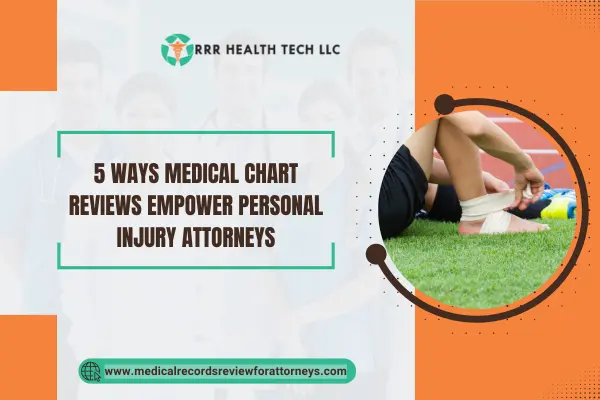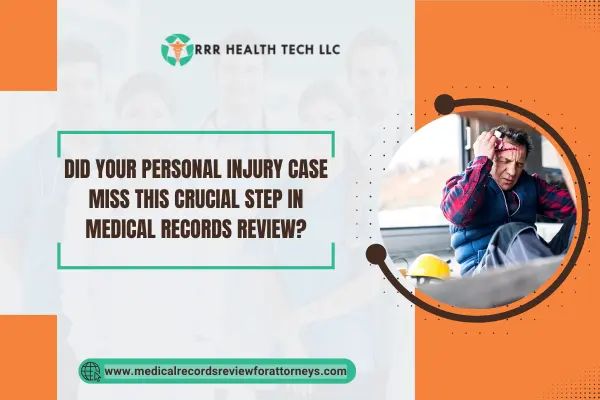
Introduction
Incapacitating injuries profoundly impact the victims and are associated with lifetime physical and emotional suffering. For attorneys practicing in personal injury areas, these injuries present unique challenges. This article explains the definition, examples, and consequences associated with such injuries, together with medical record review analysis, which is imperative to building strong compensation claims.
Definition and Overview
• Incapacitating injuries are an assortment of physical or psychological conditions that are so extreme they make performing an individual’s daily activities impossible.
• Though a person may still sustain life with these kinds of injuries, the person might become unable to function fully. As a result, they may need extensive medical treatment and rehabilitation.
Key Characteristics
• Severity: As a result of incapacitating injuries, there is a significant lesion in the associated body part and loss of bodily function.
• Medical Attention: Sustaining an Incapacitating injury means a person need immediate medical attention and follow up treatment.
• Life impact: Mobility, independence, and how the quality of the injured person’s life is further diminished and adversely affected.
Common Types of Incapacitating Injuries
• Spinal Cord Injuries: Leads to paralysis and therefore loss of sensation.
• Traumatic Brain Injuries (TBI): Cognitive impairment and emotional disturbance is the result.
• Severe Lacerations and fractures: Surgery is always necessary after an injury of this nature, and the recovery period is long.
• Burn Injuries: These injuries can lead to physical, as well as emotional, trauma.
• Internal Injuries: These injuries are often concealed; however, they can be fatal in nature.
Comparison with Other Injury Classifications
• Incapacitating vs. Catastrophic Injuries: Both types are serious in nature; however, catastrophic often results in a permanent form of disability while incapacitating form can still heal.
The KABCO Injury Scale
• The KABCO scale assigns the values of the injuries based on how severe they are, enabling first-aid responders, as well as the medical professionals to assess the situation promptly.
• Definition of Unique KABCO Injury Scale. Any injury, which is deemed nonfatal, but results in inability to carry out routine activities, and results in seeking medical attention, qualifies for this.
State Variations
• States have unique laws and regulations, meaning other states can have different definitions and classifications under the KABCO scale which can affect legal claims alongside reimbursement.
Consequences of Incapacitating Injuries
Financial Implications
• Victims often incur enormous medical expenses, incurring wages due to not being able to work, and great expenses for long-term rehabilitative therapy.
• Managing the financial cost becomes near impossible, increasing the need of legal recourse to sue for payment of these damages.
Emotional and Psychological Effects
• Many individuals are emotionally traumatized, struggling with anxiety and depression which makes the recovery process more complicated.
The Role of Medical Records Review in Personal Injury Cases
Importance for Attorneys
• Getting the medical records allow them to build great cases for their clients, making the review of these records pivotal for the progress of the case.
• Personal injury compensation claims can be influenced by the accuracy of reporting injuries, treatments given, and prognosis made.
How We Assist Attorneys
• We assist in reviewing medical records to determine information that may be helpful in supporting claims.
• These services enable the attorneys to appreciate the full extent of the injuries sustained by their clients and the costs involved.
Common Questions Addressed
What Should Victims Do After an Incapacitating Injury?
• Get medical assistance as soon as possible.
• Maintain records of all injuries and the remedies attempted.
• Get in touch with a personal injury attorney who should advise legal jurisdiction and remedies available.
How Can Attorneys Strengthen their Cases?
• Make use of medical records review to collect evidence.
• Pay attention to the details of incapacitating injuries and how these injuries may impact the compensable amount.
Case Studies
Case Study 1: Spinal Cord Injury from a Car Accident
• Overview: This case concerns a 35-year-old male who sustained a spinal cord injury when he was involved in a car accident where he was hit from the rear.
• Challenges: The injury led to partial paralysis which meant that he needed considerable rehabilitation input to walk again.
• Solutions: His medical records were reviewed to determine the injury and the associated treatment costs in detail.
Case Study 2: Brain Trauma Injury from fall in Grocery Store
• Overview: This case concerns a TBI suffered by a female aged 50 years after she slipped on a wet surface in a grocery store.
Challenges: The injury resulted in mental dysfunctions and negative feelings.
Solutions: A detailed examination of the patient’s medical files revealed the ramifications of the injury.
Conclusion
These life-altering injuries not only impact the victims, but place them family members under emotional distress. These types of injuries require a more thorough examination coupled with a review of the medical files which will ensure the attorney is able to offer these clients the fair reimbursement they deserve. Keeping up to date and having access to a multitude of materials allows legal practitioners to help advocate and defend the clients’ claims.


